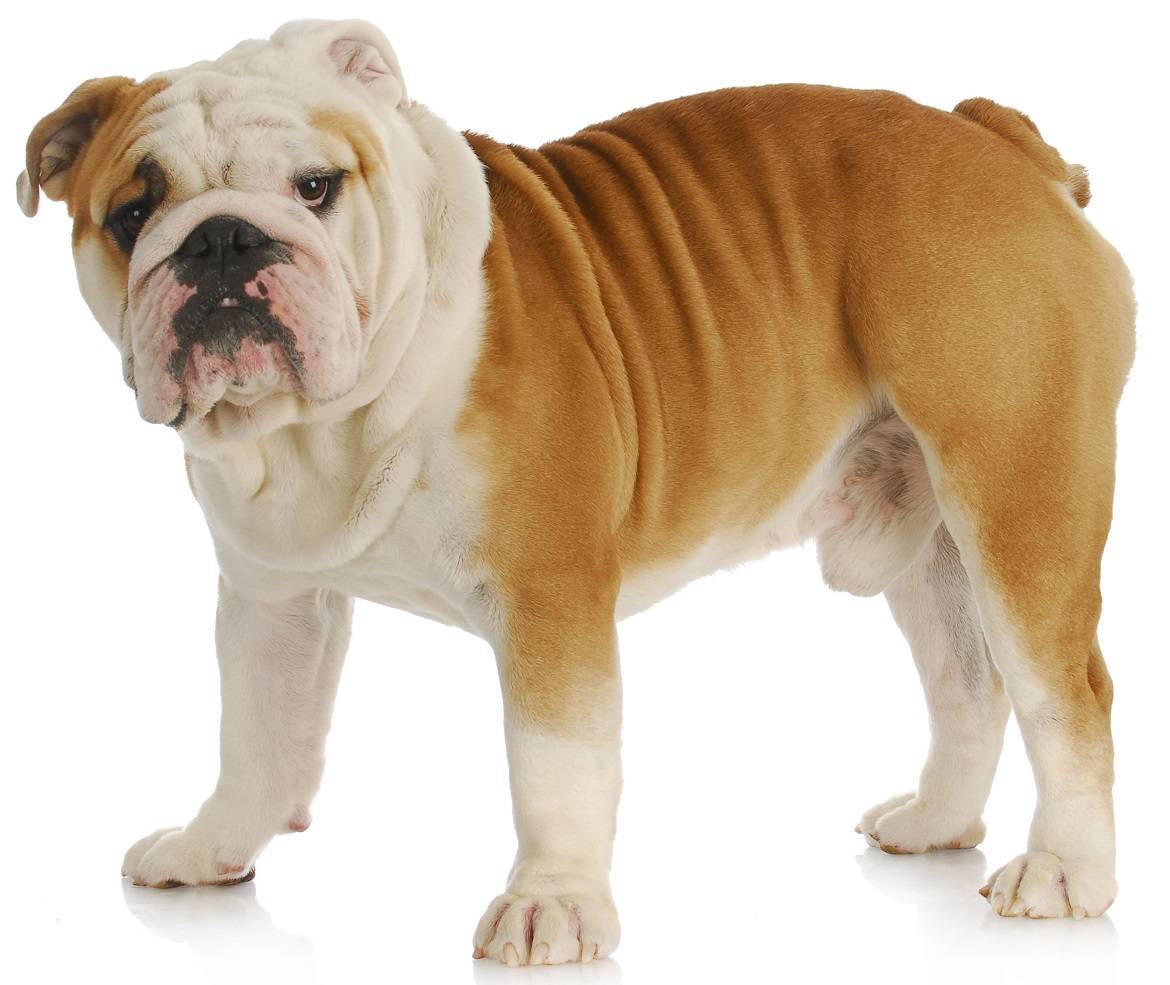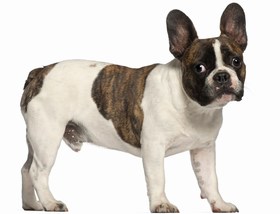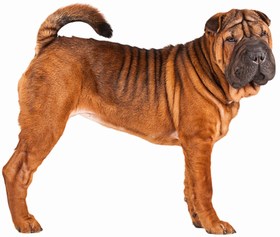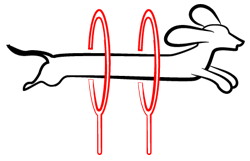
Paws ‘N’ Pups Quickview
Size
| Energy Level
| Trainability
| Paws ‘N’ Pups Rank
|
Characteristics
| Physical Characteristics: Height: 12-15” Weight: 40-50 lbs. Energy Level: Low – Moderate | Health & Longevity: 8-10 years Breeders screen for the following conditions:
|
The American Kennel Club recognizes the English Bulldog in the following colors:
| English Bulldogs can also have the following markings:
|
In addition to the health conditions listed above, demodectic mange is also seen. Bulldogs sometimes experience head tremors, which can be the result of a variety of causes. Like other short-nosed (brachycephalic) breeds, the Bulldog can experience challenges navigating everyday life. They cannot tolerate temperature extremes; their short coat provides no protection from cold, wet weather, and their shortened muzzles and heavy bodies make it difficult for them to cool themselves in warmer temperatures; high humidity makes this even more difficult. Protection from the cold during walks is easily provided with a coat; however, being housed outdoors is not recommended. In higher temperatures, these dogs must be housed in air-conditioned quarters; as little at 30 minutes in 85 degree temperatures can kill them. Exercise, including walks, must be provided only during early morning or nighttime when temperatures are lower. For those living near or frequently visiting bodies of water, care must be taken to ensure the safety of your dog. With large heads, heavy bodies and short legs, Bulldogs are notoriously bad swimmers, and must be outfitted with a properly fitted flotation device.
Allergies are also common, which can express themselves in many ways; ear infections, skin itchiness and chewing, hot spots, and gas. It is recommended that a harness be used to avoid putting any additional pressure on the airway. Bulldogs are sensitive to anesthesia, so if surgery is necessary, check to be sure your veterinarian is experienced monitoring Bulldogs.
Temperament & Train-ability
Amiable, frisky, and sometimes a bit apathetic, the Bulldog has a following of fiercely loyal owners who gladly tolerate their quirks to share their lives with these clowns. Bulldogs are suitable for apartments, condos and those with small yards. Novice dog owners should not be overwhelmed with a Bulldog as long as they are prepared to care for their physical challenges. Bulldogs often make good family dogs, being amiable and sturdy enough for small children. Indeed, Bulldogs seem to get along with everyone; they are typically friendly even to strangers. But it is the Bulldog’s family that they shower with affection. Despite his job change from bull-baiter to companion, one must always remember that this dog is a bulldog; it can be nigh to impossible to change his mind once he’s decided to do something. He may get along with other animals, but males can lock horns with other males.
The Bulldog’s exercise needs are easily met with walks, which he may not be eager for, but are important to keep him fit and healthy. When the walk is over, you’ll probably find him napping on the sofa. Bulldogs are relatively inactive indoors…some would say lazy. Although the Bulldog can nap away some time alone, they will be incredibly unhappy with long hours alone. In addition to living with a lot of shedding, Bulldog owners must be able to tolerate the snorting, grunting, snoring, slobber, drool, and gas produced, sometimes in copious amounts. A simple drink at the water bowl can turn the floor into a lake, following the dog’s path across the room. Every shake of the head will result in slobber being flung near and far. But all this doesn’t dissuade those who love this breed.
The training of a bulldog is not for the faint of heart; one will need patience, fortitude, and a sense of humor. Using positive reinforcement methods will result in far less frustration for both of you; trying to push a Bulldog around isn’t going to get you anywhere. Be prepared to repeat lessons a few times before your dog gets it; but once he’s got it, he’s got it. Bulldogs need early and continued socialization to assure they see the world as filled with OK people and things rather than seeing threats everywhere. There have been Bulldogs competing in traditional sports like obedience, but you won’t find many; if training together is what you look forward to, the Bulldog is not the breed for you.
Grooming
Although easy care, don’t be fooled by the smooth coat of the Bulldog; these dogs shed a lot, and their coat sticks in fabric, making removal sometimes difficult. A weekly brushing with a soft bristle brush or curry will help keep excess hair off the floor (and you). During the spring and fall, coat shed will increase significantly, and daily brushing may be necessary.
Care should be taken to keep any wrinkles and skin folds clean and dry or they can become havens for bacteria to grow. Ears must be cleaned regularly, and toenails will need to be trimmed, as most Bulldogs will not wear their nails down even if walked on concrete. Teeth should also be checked and cleaned as necessary.
Diet
The amount fed will vary depending on age, activity level, and type of food fed; on average, a Bulldog will eat ½-2 cups of food per day, which should be fed in two meals. Free feeding should be avoided, as Bulldogs are very prone to becoming overweight. If your Bulldog experiences food-related allergies and sensitivities, some experimentation to find a food your dog can tolerate may be needed. A constant supply of fresh, clean water must always be available.
Looking for a English Bulldog?
 Find A English Bulldog Breeder |  English Bulldog Puppies For Sale |  Adopt A English Bulldog |
Cost
The price tag for a Bulldog is usually steep: $2,500-$3,500, and on up to as much as $25,000. Many people choose to adopt a dog through a breed rescue organization. Adoption fees are normally $200-$500, but some Bulldog rescues charge a higher fee.
With airline restrictions on flying brachycephalic dogs, it may be necessary to add considerable travel expenses and driving time to get your new dog home. As with many purchases, the initial purchase price of any dog is only the beginning of the money you’ll spend. Buying supplies, food, and regular vet visits all add up; even in well-bred dogs, Bulldogs have a fairly high need for regular and ongoing vet care.
Paws ‘N’ Pups Ranking
Paws ‘N’ Pups ranks every breed out of 4 with 1 being easiest to integrate into your life and 4 being the toughest – The lower the ranking the better.
Ranking takes into account a few basic factors such as cost, skill level needed, high vs. low maintenance, and how critical regular training is to success. The Bulldog rates a 3.5, primarily due to their cost and health challenges.
Breeds Similar To English Bulldog
 French Bulldog |  Bull Terrier |  Bullmastiff |  Chinese Shar-Pei |




